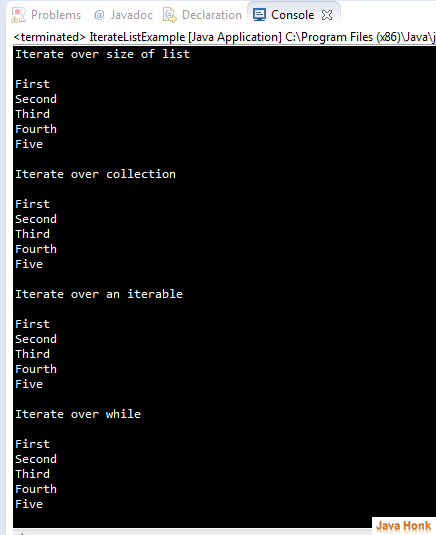Iterate list Java
An ordered collection (also known as a sequence). The user of this interface has precise control over where in the list each element is inserted. The user can access elements by their integer index (position in the list), and search for elements in the list.
Unlike sets, lists typically allow duplicate elements. More formally, lists typically allow pairs of elements e1 and e2 such that e1.equals(e2), and they typically allow multiple null elements if they allow null elements at all. It is not inconceivable that someone might wish to implement a list that prohibits duplicates, by throwing runtime exceptions when the user attempts to insert them, but we expect this usage to be rare.
The List interface places additional stipulations, beyond those specified in the Collection interface, on the contracts of the iterator, add, remove, equals, and hashCode methods. Declarations for other inherited methods are also included here for convenience.
The List interface provides four methods for positional (indexed) access to list elements. Lists (like Java arrays) are zero based. Note that these operations may execute in time proportional to the index value for some implementations (the LinkedList class, for example). Thus, iterating over the elements in a list is typically preferable to indexing through it if the caller does not know the implementation.
The List interface provides a special iterator, called a ListIterator, that allows element insertion and replacement, and bidirectional access in addition to the normal operations that the Iterator interface provides. A method is provided to obtain a list iterator that starts at a specified position in the list.
The List interface provides two methods to search for a specified object. From a performance standpoint, these methods should be used with caution. In many implementations they will perform costly linear searches.
The List interface provides two methods to efficiently insert and remove multiple elements at an arbitrary point in the list.
Below example will show you different ways to iterate list:
package com.javahonk.list; import java.util.ArrayList; import java.util.Iterator; import java.util.List; public class IterateListExample { public static void main(String[] args) { List<String> list=new ArrayList<String>(); list.add("First"); list.add("Second"); list.add("Third"); list.add("Fourth"); list.add("Five"); System.out.println("Iterate over size of list\n"); for (int i = 0; i < list.size(); i++) { System.out.println(list.get(i)); } System.out.println("\nIterate over collection\n"); for (Iterator<String> iterator = list.iterator(); iterator.hasNext();) { String string = (String) iterator.next(); System.out.println(string); } System.out.println("\nIterate over an iterable\n"); for (String string : list) { System.out.println(string); } System.out.println("\nIterate over while\n"); int i = 0; while (i < list.size()) { System.out.println(list.get(i)); i++; } } }
Output:
Reference: Sun Java documentation
